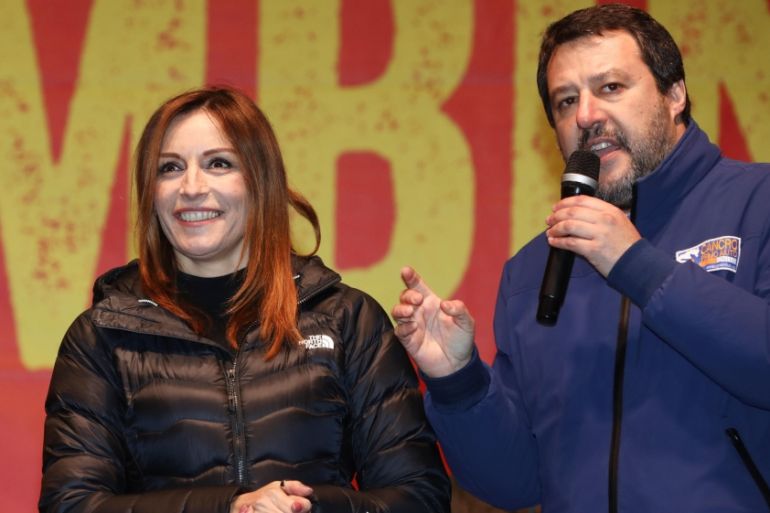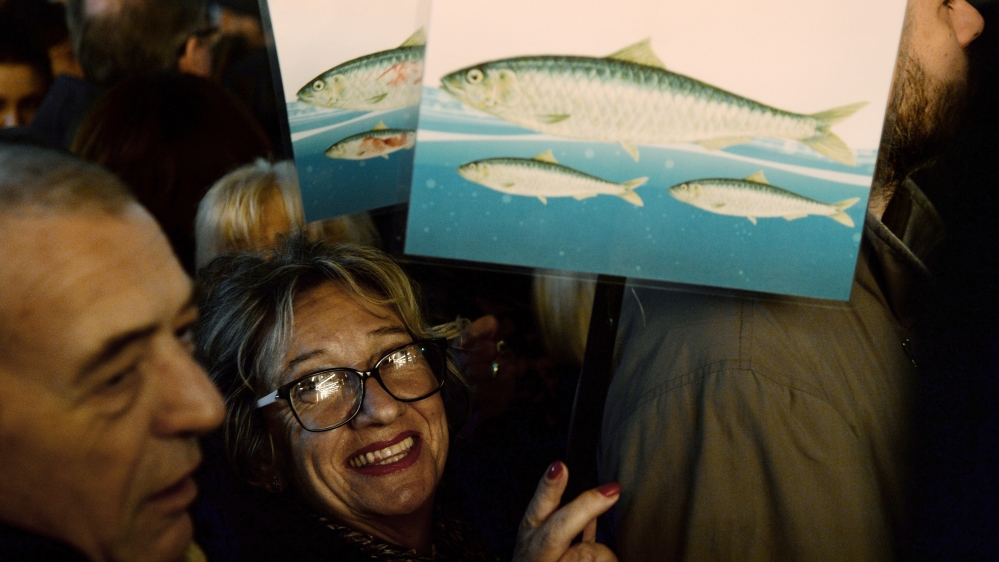Emilia-Romagna: Will Italy’s left-wing stronghold turn far-right?
Emilia-Romagna, traditionally a red region, prepares for political earthquake as it heads towards regional poll.

Forli, Italy – In the summer of 1944, the German administration of Nazi-occupied Italy confiscated the lead characters used by all printing houses in the city of Forli, in the northern region of Emilia-Romagna.
Anti-fascist newspapers continued to be printed clandestinely – 16 in the city alone.
Keep reading
list of 4 itemsGerman blue-chips warn of ‘extremist’ threat before EU elections
Germany’s Scholz calls for unity against far-right after MEP seriously hurt
‘No turning back’: Carnation Revolution divides Portugal again, 50 years on
A lot of that work, including prints and engravings, is now stored at the Institute of the Resistance and Contemporary History.
This sleepy city of 100,000 has been governed by left-wing parties for about half a century.
Like the region itself, it was considered a left-wing stronghold – until it elected a League mayor last summer.
Alongside the southern region of Calabria, Emilia-Romagna will go to the polls on January 26 to pick a new regional government in elections that have been widely anticipated to usher in a further victory for the League, the far-right party of former interior minister and deputy prime minister Matteo Salvini.
The last published polls have put the League candidate, supported by a right-wing coalition, senator Lucia Borgonzoni, just a couple of points behind the current president of the region, Stefano Bonaccini.
Bonaccini is running with a centre-left list that includes his own Democratic Party (PD) and polls at over 45 percent.
Not only is Emilia-Romagna the largest and most populous of Italy’s “red regions”, it is also one of the richest in Italy.
Unemployment levels are well below the national average – despite considerable inequality between urban and industrial areas and left-behind villages in the mountain areas.
“Positive economic and social indicators in the areas of welfare, public health and employment levels, in fact, hide a number of issues,” Carlo De Maria, the Institute’s director and a senior researcher in contemporary history at the University of Bologna, told Al Jazeera.
“Take unemployment levels, for example. They may be low, but the quality of work has, in fact, been getting worse. There is more precariousness and uncertainty,” he added.
“Some people can be sceptical of all the talk about good governance and perceive it as untrue, particularly those living in the suburbs or the Apennine.”
The League has been dominating Italian politics since it entered a coalition with the anti-establishment Five Star Movement (M5S) after the 2018 general elections. In a surprise move last summer, Salvini decided to pull the plug on that government, hoping to induce, and win, new elections.
His party had easily won the European elections earlier in May with 34 percent of the vote, more than doubling its share of consensus from the last general election in 2018, when it stood at 17 percent.
Much of the months-long public debate that preceded these local elections has been centred around whether Italy’s EU-approved new coalition government, which includes the centre-left PD and the M5S, can survive a League win in Emilia-Romagna.
The recent resignation of Salvini’s former ally, Luigi di Maio, as head of the M5S prompted fresh speculation. In late 2019, the League bagged a win in another region in Italy’s “red belt”, Umbria.
“I haven’t voted for about 10 years. But this year, I will vote against the PD,” 62-year-old Oronzo Campagna, a pensioner, told Al Jazeera. Campagna says he has voted left all his life, but that he’s tired of seeing “the same old faces”.
It is the ultimate challenge between a predatory, pessimist nationalism and what used to be the 'better Italy'.
Participation at the last regional election in 2014 was 38 percent, a record low, making Sunday’s result difficult to predict.
“Yes, mine is a protest vote. The PD continues to stay in government without winning elections,” he added.
Regional governance appears to have little influence on the way voters like Campagna, who could not recall the League candidate’s name, will swing.
The party’s messages on security, particularly in relation to migration, and “renewal”, aiming to “liberate Emilia-Romagna” from the centre-left, have resonated among some voters.
“There are people in Italy who struggle to get to the end of the month, have nothing to eat. Let’s think about us, Italians, first,” said Campagna, a former shipyard worker.
Migrant and refugee arrivals to Italy have dropped dramatically since the previous left-wing government reached a deal with the Libyan Government of National Accord (GNA) in 2017.
Party leader Salvini has been campaigning aggressively in Emilia-Romagna since late last year, rallying supporters to local squares.

But it is also on the streets of Emilia-Romagna that the anti-populist Sardines movement entered the Italian political scene last November.
Widespread protests began with a call for a flash-mob in Bologna to outnumber a League rally taking place in a nearby square. The event, called “6,000 Sardines against Salvini”, drew twice as many people as it expected to.
Since then, the Sardines have packed squares across the country, drawing 40,000 to Rome late last year, and as many in Bologna for a pre-election rally on January 19.
“I support it as a protest movement, I think it is completely legitimate,” said Martina Sbrighi, 25, who works in a bookstore in Forli.
She took part in recent protests, in which participants raise cardboard fish cutouts, anti-racist banners and chant the anti-fascist resistance anthem, Bella Ciao.
“Obviously, you also need to put forward a real alternative, as well, and I am a bit sceptical,” Martina said, adding that she will likely vote for the left-wing candidate, Bonaccini, while still feeling a lack of representation.
“I probably support a left that no longer exists,” she added.
The young organisers of the protests have so far ruled out morphing the movement into a political party. However, while a recent poll showed that 30 percent of Italians believe the League will dominate Italian politics in the near future, as many as 27 percent think it will be a new, unspecified political actor.
The Sardines have called a national meeting on March 8.
Other young voters have looked to fill the perceived representational void elsewhere.
“Italy has nothing to envy other countries, in Europe and beyond. But our culture has been sidelined by globalisation,” said Francesco Maria, a 22-year-old psychology student and bartender.
He supports the rising far-right nationalist party Brothers of Italy.
“We talk about things that shouldn’t be a priority, like the arts and immigration,” he continued.
Meanwhile, despite no longer being in government, Matteo Salvini has continued to keep a high media profile through the election campaign.
“Salvini knows he has chosen a weak candidate, and he’s spent days going to the most unlikely of places [in Emilia-Romagna],” Carlo Ruzza, professor of political sociology at the University of Trento, told Al Jazeera. “His electoral campaign is a national one, what he’s selling is a formula for the whole of Italy.”
“It is the ultimate challenge between a predatory, pessimist nationalism and what used to be the ‘better Italy’,” Ruzza said. “It should be seen as part of a much wider global challenge.”